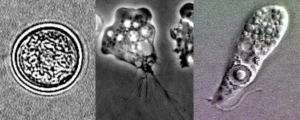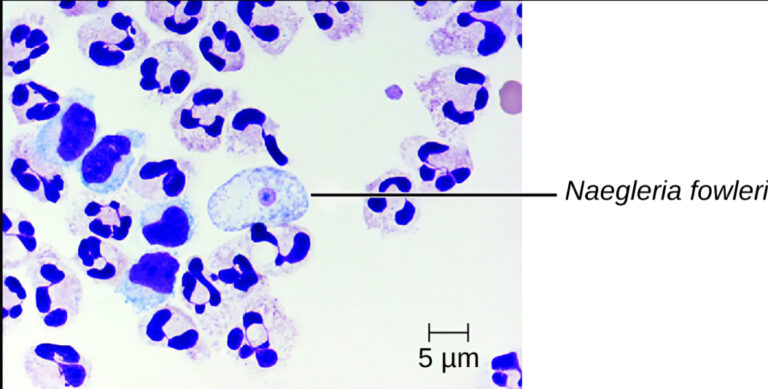What is the Brain Eating Amoeba? New Case in Texas :-
What is the Brain Eating Amoeba? New Case in Texas. Few organisms inspire as much fear as Naegleria fowleri, often called the “brain-eating amoeba.” Despite its terrifying nickname, this microscopic organism is not a common threat, but when infections do occur, the consequences are almost always fatal. Recent news and scientific updates have brought renewed attention to this rare but deadly pathogen, especially following several high-profile cases in 2025.
What is Naegleria fowleri?
Naegleria fowleri is a single-celled, free-living amoeba that thrives in warm freshwater environments. It is commonly found in lakes, rivers, hot springs, and sometimes in inadequately chlorinated swimming pools or even tap water. This amoeba is capable of surviving in soil as well, forming dormant cysts under unfavourable conditions. While it primarily feeds on bacteria in the environment, it can become pathogenic if it enters the human body through the nose.

How Does Infection Occur?
Infection with Naegleria fowleri, which leads to a condition called primary amebic meningoencephalitis (PAM), occurs when contaminated water enters the nose. This can happen during activities such as swimming, diving, or jumping into warm freshwater. Less commonly, infection has been linked to using tap water in devices like neti pots for nasal irrigation, or even through inhaling contaminated dust. Once inside the nasal cavity, the amoeba travels along the olfactory nerve to the brain, where it begins to destroy brain tissue.
It’s important to note that simply drinking contaminated water does not cause infection; the amoeba must enter through the nasal passages. Furthermore, there is no evidence that the infection can be spread from person to person.
Symptoms and Disease Progression
The onset of symptoms typically occurs between one and twelve days after exposure, with most cases developing around five days post-infection. Early symptoms may seem mild and nonspecific, including:
-
Headache
-
Fever
-
Nausea
-
Vomiting
However, the disease rapidly worsens. As PAM progresses, patients may experience:
-
Stiff neck
-
Confusion
-
Loss of balance
-
Seizures
-
Hallucinations
-
Lack of attention to people and surroundings
Death usually follows within five days of symptom onset, though the range can be from one to eighteen days. The fatality rate for PAM is alarmingly high—over 97%—and only a handful of survivors have been documented worldwide.
Recent Cases and Public Health Concerns
In 2025, several new cases have brought Naegleria fowleri back into the public eye. One notable incident involved a woman in Texas who died after using tap water in a nasal irrigation device while camping. Laboratory analysis confirmed the presence of the amoeba in her cerebrospinal fluid. Other cases have been reported in the United States and globally, including a fatality in Karachi, Pakistan, underscoring that this threat is not limited to any one region.
While infections remain rare—fewer than ten cases are reported annually in the United States—the near-universal fatality rate and the potential for exposure through everyday activities like swimming or nasal rinsing have raised concern among health authorities.
Why Is Infection So Rare?
Despite the widespread presence of Naegleria fowleri in warm freshwater, infections are extremely rare. Between 1962 and 2023, only 164 cases were reported in the United States, with just four survivors. The reasons for this rarity are not fully understood, but it is believed that a combination of environmental, behavioural, and possibly genetic factors play a role.
Prevention: How to Protect Yourself
Given the severity of PAM, prevention is crucial. Here are some effective strategies to reduce your risk:
-
Avoid getting water up your nose when swimming in warm freshwater lakes, rivers, or hot springs.
-
Use nose clips or keep your head above water in potentially risky environments.
-
Do not use tap water for nasal irrigation unless it has been boiled, filtered, or treated to ensure it is free of the amoeba.
-
Properly maintain swimming pools and hot tubs with adequate chlorination.
-
Be cautious with recreational water activities during hot weather, when water temperatures are higher and amoeba populations may increase.
Final Thoughts
While the “brain-eating amoeba” is a rare threat, its deadly potential makes awareness and prevention essential. Understanding how Naegleria fowleri infects humans, recognizing the early symptoms, and following safety guidelines can help minimize the already low risk of infection. Health officials continue to monitor cases and advise the public on best practices, especially as climate change and rising temperatures may expand the amoeba’s habitat in the future.
If you experience symptoms of severe headache, fever, or neurological changes after recent freshwater exposure, seek medical attention immediately. Early intervention remains the best hope, though survival rates are still extremely low. Stay informed, stay cautious, and remember that knowledge is your best defence against this rare but deadly organism.

